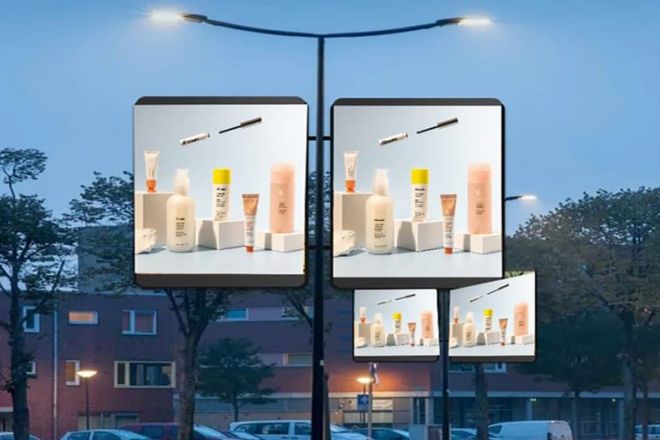Introducción

Con el rápido desarrollo de la ciencia y la tecnología, la tecnología de las pantallas de visualización cambia cada día que pasa.
Como dos tecnologías de visualización convencionales, pantallas LED de poste y las pantallas LCD juegan un papel importante en sus respectivos campos. Las pantallas LED de poste han demostrado una fuerte competitividad en la publicidad exterior, las instrucciones de tráfico y otros campos con su alto brillo, alta definición, ahorro de energía y otras características, mientras que las pantallas LCD han demostrado una fuerte competitividad en la publicidad interior con su alta resolución, bajo consumo de energía y otras características.
Ocupa un lugar en los campos de la exhibición, la exhibición comercial y otros. Este artículo tiene como objetivo comparar el rendimiento, las ventajas, las desventajas y los escenarios de aplicación de las pantallas LED y LCD para postes con el fin de proporcionar una referencia para la selección y aplicación de tecnología en campos relacionados.
1. Descripción general de la pantalla LED de poste

1) Definición y características de la pantalla LED de poste
Definición: La pantalla LED para postes se refiere a una pantalla LED especialmente montada en un poste de alumbrado público. Integra la unidad de visualización, el sistema de control, la fuente de alimentación y otras partes para formar un sistema de visualización completo.
Componentes principales: Incluye marco estructural de metal, unidad de visualización (compuesta por luces LED y circuitos de control), placa de control de escaneo, fuente de alimentación conmutada, cables de transmisión, controlador principal, tarjeta de visualización especial y tarjeta multimedia, etc.
2) Características:
Brillo alto: La pantalla LED de poste utiliza un LED de alto brillo como fuente de luz, que puede ser claramente visible incluso en condiciones de fuerte iluminación exterior.
Alto Definición: Utilizando tecnología de visualización avanzada y luces LED de alta resolución, puede presentar imágenes y textos claros y delicados.
El ahorro de energía: Las pantallas LED para postes tienen la característica de bajo consumo de energía, lo que puede reducir significativamente el consumo de energía en comparación con los métodos tradicionales de iluminación y publicidad.
Larga vida: Las luces LED suelen tener una vida útil prolongada, lo que puede reducir los costos de mantenimiento y extender la vida útil de la pantalla del poste de luz.
3) El principio de funcionamiento de la pantalla LED de poste
Principio de iluminación LED: La luz LED es un dispositivo semiconductor de estado sólido que puede convertir directamente la energía eléctrica en energía luminosa. Cuando la corriente pasa a través del LED, los electrones y los huecos se recombinan en la unión PN, liberando fotones para formar luz.
Aplicación de pantalla LED de poste: La pantalla LED utiliza múltiples luces LED para formar píxeles y muestra imágenes e información de texto controlando el brillo y el cambio de color de cada píxel.
Método de accionamiento y control: La pantalla LED de poste adopta un sistema de control avanzado, que se puede administrar y controlar de forma remota a través de computadoras, teléfonos móviles y otros dispositivos para lograr una actualización y visualización de contenido en tiempo real.
4) Ventajas técnicas de las pantallas LED para postes
Alta reproducción de color: La pantalla LED del poste utiliza luces LED a todo color, que pueden presentar colores más realistas y vívidos y mejorar la experiencia visual.
Amplio ángulo de visión: Las pantallas LED de poste generalmente tienen un ángulo de visión más grande, lo que permite una visualización clara desde diferentes ángulos para satisfacer las necesidades de más espectadores.
Gestión inteligente: Las pantallas LED de poste tienen funciones como atenuación inteligente y control de temperatura, y pueden ajustarse automáticamente según los cambios y necesidades ambientales, mejorando el rendimiento y la estabilidad del equipo.
Respetuoso con el medio ambiente y libre de contaminación: Las pantallas LED en postes utilizan fuentes de luz LED de bajo consumo, que no contaminan ni emiten radiación y cumplen con los requisitos del desarrollo sostenible.
Alto retorno de la inversión: Las pantallas LED en postes pueden cambiar el contenido publicitario en cualquier momento, aumentar los espacios publicitarios, reducir los costos marginales y aumentar el retorno de la inversión.
2. Descripción general de la pantalla LCD
1) Definición y características de la pantalla LCD
- Definición: LCD, nombre completo pantalla de cristal líquido, es un dispositivo de pantalla plana que muestra imágenes cambiando el estado de transmisión de la luz a través de la desviación de las moléculas de cristal líquido.
2) Tipos principales:
TN (Nemático retorcido): Twisted Nematic, un tipo temprano de LCD, con bajo costo, pero con un ángulo de visión y rendimiento de color relativamente pobres.
IPS (conmutación en el plano): Tipo de conmutación en el plano con excelente ángulo de visión y rendimiento de color, ampliamente utilizado en monitores y televisores de alta gama.
VA (Alineación vertical): Tipo de alineación vertical, con alto contraste y ángulo de visión más amplio, pero velocidad de respuesta ligeramente más lenta.
3) Características:
Alta resolución: La pantalla LCD puede lograr una visualización de alta resolución y proporcionar imágenes y texto claros y detallados.
Bajo consumo de energía: En comparación con los monitores CRT tradicionales, los LCD consumen menos energía, ahorran energía y son respetuosos con el medio ambiente.
Delgado, ligero y portátil: La pantalla LCD es de tamaño pequeño y liviano, lo que hace que sea fácil de transportar e instalar.
4) Cómo funciona la pantalla LCD
- Principio de la pantalla de cristal líquido: La pantalla LCD utiliza las propiedades físicas del cristal líquido. Cuando se aplica electricidad, las moléculas del cristal líquido se disponen de manera ordenada, lo que permite que la luz pase fácilmente; cuando no se aplica electricidad, las moléculas del cristal líquido se disponen de manera desordenada, lo que impide que la luz pase, lo que permite visualizar imágenes.
5) Componentes clave:
Iluminar desde el fondo: Las pantallas LCD requieren módulos de retroiluminación para proporcionar fuentes de luz. Los tipos de retroiluminación más comunes incluyen CCFL (lámpara fluorescente de cátodo frío) y LED (diodo emisor de luz).
Filtro de color: La pantalla LCD utiliza filtros de color para convertir la luz blanca emitida por la retroiluminación en tres colores primarios, luz roja, verde y azul, y luego controla la transmisión y el bloqueo de la luz a través de la desviación de las moléculas de cristal líquido, presentando así una imagen en color.
6) Ventajas técnicas de las pantallas LCD
Rendimiento de color: Las pantallas LCD utilizan tecnología avanzada de procesamiento de color para presentar colores más vivos y realistas. Especialmente en los modelos de gama alta, como IPS y VA, el rendimiento del color es aún mejor.
Contraste: Las pantallas LCD tienen un alto contraste y pueden presentar imágenes más claras y nítidas, especialmente en términos de detalles oscuros y niveles de color.
Tiempo de respuesta: Aunque el tiempo de respuesta de la pantalla LCD es ligeramente más lento que el de las nuevas tecnologías de visualización como OLED, es lo suficientemente rápido en aplicaciones comunes y no produce fenómenos obvios de manchas o de persistencia de imágenes. Especialmente en los tipos de alta gama como IPS y VA, el tiempo de respuesta ha mejorado considerablemente.
Ángulo de visión: Las pantallas LCD suelen tener ángulos de visión más grandes, especialmente los tipos IPS y VA, por lo que los usuarios pueden ver claramente el contenido de la pantalla en una amplia gama de ángulos.
Protección del medio ambiente y ahorro de energía: La pantalla LCD adopta un diseño de bajo consumo de energía y cumple con los requisitos de ahorro de energía y protección del medio ambiente. Al mismo tiempo, su proceso de producción también presta más atención a la protección del medio ambiente y la sostenibilidad.
3. Comparación de rendimiento entre pantallas LED y LCD

1) Brillo y contraste
1.1) Rendimiento de brillo:
Pantalla LED de poste: En ambientes exteriores, las pantallas LED con postes, con su alto brillo, pueden mantener una visualización claramente visible incluso bajo una luz intensa. Las pantallas LED responden más rápido que las LCD, por lo que tienen una ventaja en el brillo.
Pantalla LCD: Aunque la pantalla LCD tiene un buen rendimiento de brillo en ambientes interiores, cuando se expone a una luz intensa en exteriores, su efecto de visualización se verá muy afectado y pueden producirse reflejos o visibilidad poco clara.
1.2) Diferencia de contraste:
Pantalla LED de poste: Debido a sus características de autoiluminación, la pantalla LED de poste puede presentar un mayor contraste, especialmente cuando se muestra en negro, puede mostrar un efecto negro más puro.
Pantalla LCD: Dado que la pantalla LCD depende de un módulo de retroiluminación para emitir luz, puede ser ligeramente inferior a la pantalla LED en términos de contraste, especialmente en el rendimiento de los detalles oscuros.
2) Ángulo de visión y alcance visual
2.1) Alcance de visión:
Pantalla LED de poste: Por lo general, proporciona un amplio rango de ángulos de visión de hasta 160°, lo que permite a los espectadores ver claramente el contenido de la pantalla desde diferentes ángulos.
Pantalla LCD: Su ángulo de visión suele ser estrecho, generalmente de unos 110°. Cuando el espectador se desvía del centro de la pantalla en un ángulo amplio, pueden producirse distorsiones de color o una visibilidad poco clara.
2.2) Efecto de visualización según el ángulo de visión:
Pantalla LED de poste: Gracias a su amplio rango de ángulos de visión, los espectadores pueden obtener una mejor experiencia de visualización desde diferentes ángulos.
Pantalla LCD: Cuando el ángulo es grande y se aleja del centro, el efecto de visualización de la pantalla LCD puede verse afectado, lo que genera distorsión del color o una visibilidad poco clara.
3) Consumo de energía y vida útil
3.1) Consumo de energía:
Pantalla LED de poste: Debido a la alta eficiencia y las características de ahorro de energía de las fuentes de luz LED, las pantallas LED de poste funcionan bien en términos de consumo de energía y pueden ahorrar más energía que las LCD.
Pantalla LCD: Aunque el consumo de energía de las pantallas LCD se ha reducido en comparación con las pantallas CRT tradicionales, su consumo de energía sigue siendo mayor en comparación con las pantallas LED.
3.2) Diferencias en la esperanza de vida y factores que influyen:
Pantalla LED de poste: Las luces LED tienen una larga vida útil, generalmente decenas de miles de horas o incluso más de 100.000 horas, y su estructura de diodo emisor de luz es simple y duradera y no requiere un período de envejecimiento.
Pantalla LCD: La vida útil de la pantalla LCD se ve afectada principalmente por el módulo de retroiluminación y el panel LCD. La fuente de luz CCFL o LED del módulo de retroiluminación tiene una vida útil limitada, mientras que el panel LCD puede funcionar mal debido al uso prolongado o a daños por fuerzas externas.
3.3) Resistencia a la intemperie y nivel de protección
Pantalla LED de poste: En entornos exteriores hostiles, las pantallas LED para postes suelen tener una excelente resistencia a la intemperie y pueden soportar la influencia del viento, la lluvia, las altas temperaturas, las bajas temperaturas y otros factores adversos, manteniendo al mismo tiempo un efecto de visualización estable. Además, la pantalla LED para postes también tiene un alto nivel de protección, que puede evitar que el polvo, las gotas de agua, etc., entren en el interior de la pantalla.
Pantalla LCD: La pantalla LCD es principalmente adecuada para ambientes interiores y su resistencia a la intemperie es relativamente débil. Cuando se utiliza en un ambiente interior, el nivel de protección de la pantalla LCD también es bajo, por lo que debe prestar atención a la protección contra el polvo, el agua y otras medidas de protección. Si la pantalla LCD se utiliza en un ambiente exterior, se deben tomar medidas de protección adicionales para hacer frente al impacto de factores adversos.
4. Análisis de escenarios de aplicación.

1) Escenarios de aplicación de las pantallas LED para postes
1.1) Campo de la publicidad exterior
- Casos de aplicación:
Las pantallas LED para postes se utilizan como vallas publicitarias en las principales carreteras urbanas, autopistas, distritos comerciales y otros lugares. Al reproducir videos dinámicos, imágenes y otros contenidos, atraen la atención de peatones y vehículos y difunden información publicitaria de manera eficaz.
Por ejemplo, una determinada ciudad instaló pantallas LED en las principales intersecciones de tráfico, que transmiten miles de anuncios cada día, mejorando enormemente el efecto publicitario.
1.2) Campo de las ciudades inteligentes
En la construcción de ciudades inteligentes, las pantallas LED en postes integran una variedad de sensores y equipos de comunicación, que pueden monitorear el entorno urbano, las condiciones del tráfico y otra información en tiempo real y difundirla al público a través de la pantalla de visualización.
Por ejemplo, en el Estadio del Centro Deportivo Olímpico de Hangzhou, los postes de luz inteligentes integran iluminación inteligente, monitoreo de seguridad, monitoreo ambiental y otras funciones, brindando soporte de información integral para los Juegos Asiáticos.
1.3) Zona de instrucción de tráfico
- Casos de aplicación:
En las intersecciones de tráfico, autopistas y otros lugares, se utilizan pantallas LED en postes para mostrar lemas de tráfico, información de control de tráfico y otro contenido para recordar a los conductores que respeten las normas de tráfico y garanticen la seguridad vial.
Por ejemplo, en la primera carretera con postes multifuncionales inteligentes de Zhangjiagang, las pantallas LED de los postes están integradas con semáforos, monitoreo y otros equipos para lograr una gestión inteligente del tráfico.
1.4) Análisis de funciones
- Mejorar la imagen de la ciudad:
Como parte de la infraestructura de la ciudad, las pantallas LED en postes pueden mejorar la imagen general de la ciudad con sus hermosos diseños y funciones avanzadas.
- Promover la difusión de información:
Las pantallas LED de poste tienen la función de actualizar el contenido en tiempo real, lo que puede difundir de manera rápida y precisa información variada para satisfacer la demanda de información del público.
2) Escenarios de aplicación de LCD
2.1) Campo de exhibición en interiores
- Casos de aplicación:
En lugares interiores como hogares, escuelas y empresas, las pantallas LCD se utilizan como televisores, monitores de computadora, pantallas de salas de conferencias, etc. Por ejemplo, una gran empresa utiliza pantallas LCD en salas de conferencias para mejorar la eficiencia de las reuniones.
2,2) Área de exposición comercial
- Casos de aplicación:
En lugares comerciales como centros comerciales, supermercados y tiendas especializadas, la pantalla LCD se utiliza para la exhibición y publicidad de productos. Al reproducir videos, imágenes y otros contenidos dinámicos, puede atraer la atención de los clientes y aumentar la visibilidad y las ventas de los productos.
2.3) Área de oficinas
- Caso de aplicación:
En la oficina, la pantalla LCD se utiliza como monitor de computadora, proporcionando a los empleados un entorno de oficina eficiente y cómodo.
2.4) Análisis de funciones
- Mejorar la experiencia del usuario:
La alta resolución y claridad de la pantalla LCD pueden proporcionar efectos de imagen más realistas y vívidos, brindando a los usuarios una mejor experiencia de visualización.
- Promocionar la promoción comercial:
En el campo de la exhibición comercial, la pantalla LCD promueve la promoción comercial atrayendo la atención de los clientes y aumentando la visibilidad y las ventas del producto.
Del análisis anterior, se puede ver que las pantallas LED y LCD tienen sus propias ventajas en diferentes escenarios de aplicación y, en conjunto, brindan un apoyo efectivo para el desarrollo urbano y la promoción comercial.
Conclusión
A través de un estudio comparativo en profundidad de las pantallas de postes de luz LED y las LCD, podemos ver claramente las diferencias y ventajas entre ambos en términos de rendimiento, escenarios de aplicación, etc.
Las pantallas LED de poste muestran amplias perspectivas de aplicación en publicidad exterior, ciudades inteligentes y otros campos con su alto brillo, alta definición y otras características, mientras que las LCD, con su alta resolución, bajo consumo de energía y otras ventajas, se utilizan en pantallas interiores, pantallas comerciales y otros campos continúan brillando.
Finalmente, si quieres saber más sobre las pantallas LED, Por favor póngase en contacto con nosotros.
